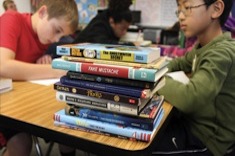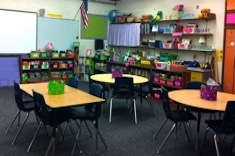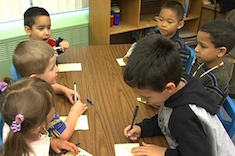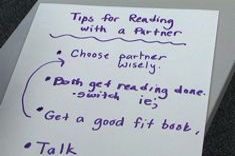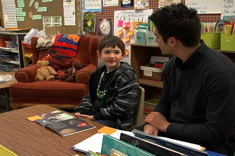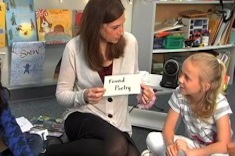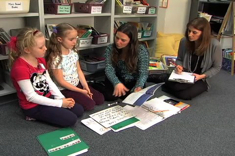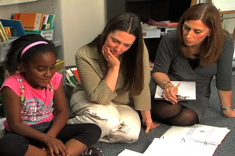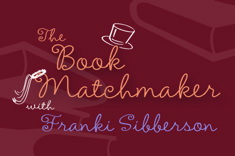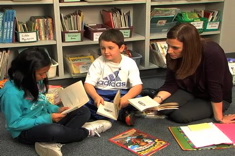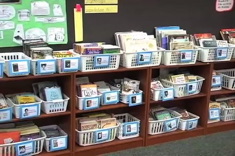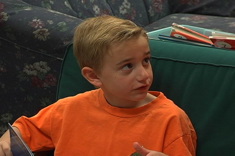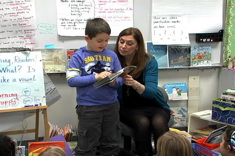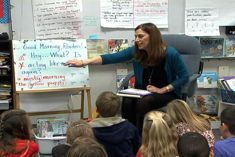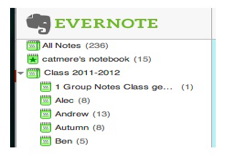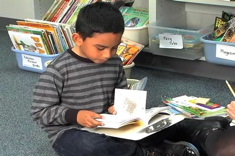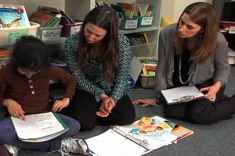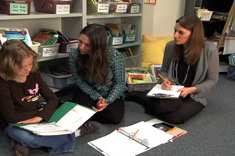2nd
Latest Content
Field Experience: Craft Moves for Elementary Writers
This field experience invites us to consider a handful of craft moves to teach young writers in minilessons, conferences and share sessions.
Field Experience: Classroom Tours
Spend time noticing the details that reflect beliefs and influence instruction. Ruth Ayres set up room tours for a field experience focused on more than trendy spaces.
Field Experience: Small Group Reading Instruction
Small group reading instruction is an important part of elementary literacy. This field experience is a sampling of a variety of examples.
Field Experience: General Workshop Routines
This field experience invites us to consider the routines of opening the day, workshop norms, meeting areas and transitions to make workshop run smoothly.
Writing, Graphic Organizers, and Mentor Texts
In this video from Sean Moore’s second-grade classroom, Sean demonstrates how to use a graphic organizer with his own writing as the mentor text.
Never Say Never: Motivation to Read from an Unlikely Source
Knock knock. Who’s there? A boy who loves sports and has no motivation for reading. Barclay Marcell discovers an unlikely source of engaging text for a child who just doesn’t enjoy books.
Are Your Writers Talking During Writing Workshop?
Stella Villalba shares practical tips for helping young English language learners collaborate with classmates and receive feedback during writing workshop.
Partner Reading: Helping Peers Teach Peers
In this video from Linda Karamatic’s second-grade classroom, two girls meet with Linda to develop tips to share with their classmates on how to partner read successfully.
From Rages to Rags: Conferring with Conner
When to let a child guess, and when to give the correct answer in a reading conference? That's the struggle for 2nd grade teacher Sean Moore as he confers with Conner.
Rereading Strategy: Conferring with Emily
Sean Moore confers with 2nd grader Emily about the strategy of rereading for comprehending reading and writing.
Focused Independent Reading in Second Grade
Sean Moore demonstrates how he helps students focus their independent reading with preparation and then with discussion after reading.
Found Poetry in Second Grade
Linda Karamatic teaches a small group of her second graders about found poetry.
Listen In: Strategies for Using Nonfiction Texts in Writing
The line between copying and plagiarizing can be a difficult one for young students to understand. In this video, Heather Rader and Linda Karamatic share a humane strategy for helping two second graders craft nonfiction writing.
Accuracy and Comprehension: Conferring in Second Grade
In this video from Sean Moore’s second-grade classroom, Sean confers with a student who comprehends text well but has some issues with accuracy.
Listen In: About the Author
“About the Author” blurbs are a great way to bring closure to writing in workshops. In this “Listen In,” Myia begins to construct her “About the Author” page.
Listen In: Writing Reviews
Heather Rader uses Kincaid’s intricate system for analyzing books to build a writing agenda in this writing conference.
Listen In: Maya is a Chapter Writer
Some young writers take a lot of time and encouragement on the journey to uninhibited prose, while others zip to prolific. Maya is such a writer. Heather Rader assists this proficient 2nd grade writer as her teacher observes.
Book Matchmaker: “Cool” Books for a Struggling Second Grader
Franki Sibberson selects some “cool” books for a struggling reader who wants to fit in with his 2nd grade peers.
Guiding Reading Partners: Work on Accuracy
In this reading conference from a 2nd grade classroom, Linda Karamatic pairs two children who have similar needs in reading.
Nonfiction Read Aloud
Sean Moore reads nonfiction aloud to his 2nd grade students. This is the first video in a two-part series.
If You Like Junie B. Jones, You Might Like . . .
What young learner doesn’t love Junie B. Jones? Franki Sibberson shares great texts to recommend for readers who adore Junie and might be looking for similar characters and plots.
Nonfiction Read Aloud – Part 2
Here are some more tips for nonfiction read-alouds, based on Sean Moore's reading of Plants That Eat Animals.
Fluency in Focus: Conferring with Jake
Gail Boushey confers with Jake, a seven-year-old who is setting a reading goal of developing fluency. After the conference, she debriefs with Joan Moser.
Astrigs, Asterisks, and Letting Students Lead
In this video from Linda Karamatic’s second-grade classroom, Charlie shares his punctuation “find” of asterisks with his classmates. He is reading the book Miss Child Has Gone Wild by Dan Gutman.
Noticing Words in Second Grade
In this brief video from Linda Karamatic’s 2nd grade classroom, students share words they are noticing, and Linda talks about making revisions to the wall displays of words in the classroom. She also mentions the word “wretched” which the class discussed the previous day, and how the word might be used naturally in conversations.
Conferring About Chunking Words in Second Grade
Sean Moore confers with a 2nd grader who is learning the strategy of chunking words in reading. Notice how Sean focuses the student, refers to previous conferences, and previews an upcoming whole-class reading.
Capturing Student Learning with Evernote
It can be difficult to move from print to electronic records in the classroom. After using a spiral notebook for 10 years, Cathy Mere did just that.
Words and Images: Mentor Texts for Second Grade Boys
In this conference with two of her second-grade students, Linda Karamatic shares mentor texts and tips to help them with their writing. Both boys are writing stories with strong visual components.
Listen In: Writing in Math
Heather Rader confers with 2nd grader Maya about her math writing as Linda Karamatic listens in.
Listen In: Knowing When You’re Done
When is writing finished? Heather Rader confers with a second grader over that age-old question for writers as Linda Karamatic listens in.
Browse Content By
Type
Category
- Assessment Tools
- Big Fresh Archives
- Booklists
- Choice Numeracy
- Classroom Design
- Common Core
- Community Building
- Conferring
- Content Literacy
- Digital Literacy
- English Language Learners
- Equity
- Family Relations
- Free Samples
- Guiding Groups
- Leadership
- Literacy Coaches
- Mentor Texts
- Minilessons
- New Teacher Mentors
- Podcasts
- Poetry
- Quote Collections
- Reading Strategies
- Self Care
- Struggling and Striving Learners
- Talking and Listening
- Teacher Study Groups
- Teaching Reading
- Teaching Writing
- Word Study and Vocabulary
Author
- Melissa Quimby
- Nawal Qarooni
- Gwen Blumberg
- Julie Cox
- The Lead Learners
- Hannah Tills
- Josie Stewart
- Ruth Metcalfe
- Mallory Messenger
- Becca Burk
- Jodie Bailey
- Vivian Chen
- Mary Brower
- Tiffany Abbott Fuller
- Stephanie Affinito
- Ruth Ayres
- Leigh Anne Eck
- Heather Fisher
- Shari Frost
- Julie Johnson
- Suzy Kaback
- Gigi McAllister
- Shirl McPhillips
- Melanie Meehan
- Cathy Mere
- Debbie Miller
- Tara Barnett and Kate Mills
- Tammy Mulligan
- Dana Murphy
- Bitsy Parks
- David Pittman
- Brenda Power
- Heather Rader
- Matt Renwick
- Mandy Robek
- Christy Rush-Levine
- Gretchen Schroeder
- Jen Schwanke
- Brian Sepe
- Katherine Sokolowski
- Stella Villalba
- Jennifer Vincent
Grade Level
Choice Literacy Membership
Articles
Get full access to all Choice Literacy article content
Videos
Get full access to all Choice Literacy video content
Courses
Access Choice Literacy course curriculum and training

